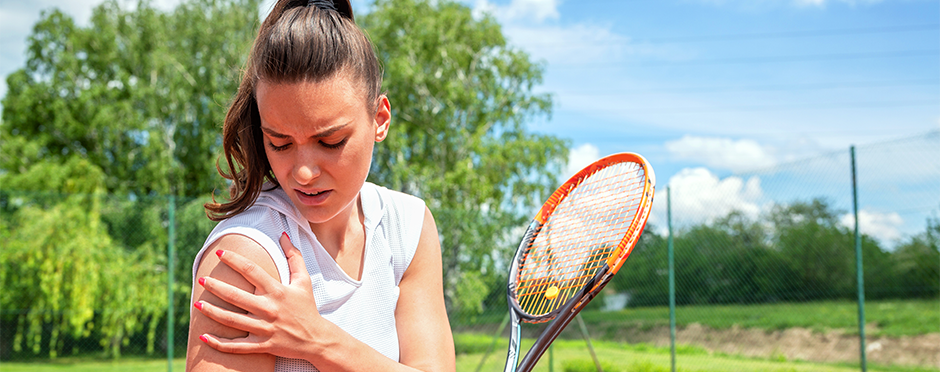
Shoulder Instability and Athletes
Leave a CommentShoulder pain is the third most common pain complaint, following lower back and knee pain, with women being more likely to experience shoulder pain than men. Common causes of shoulder pain include tendon inflammation or tears, arthritis, fractures, and instability. Instability occurs when excessive shoulder mobility results in a lack of stability, often resulting in pain, popping sensation, feeling of the shoulder “giving out,” partial dislocations, weakness, and a “dead arm” feeling. Athletes who perform repeated overhead movements are at an increased risk of developing shoulder instability.
Shoulder instability is generally classified into one of three major types of instability: anterior instability, posterior instability, and multidirectional instability3. Multidirectional instability (MDI) is characterized by global laxity or looseness of the shoulder with an instability of the shoulder or more directions and is usually associated with the insidious onset of vague, activity-related pain2,4,5.
Causes
Repetitive Microtrauma
Athletes may be at an increased risk for MDI due to repetitive overhead activity. Specific athletes at increased risk include baseball pitchers, volleyball players, gymnasts, and swimmers.
Hypermobility Disorders
Hypermobility disorders cause generalized laxity. Conditions that cause hypermobility include, but are not limited to, Ehlers-Danlos syndrome, Marfan syndrome, osteogenesis imperfecta (brittle bone disease), and benign joint hypermobility syndromes.
Treatment
MDI can be treated successfully with conservative treatment including physical therapy. Treatment can consist of exercises to improve posture, strengthen weak muscles, improve movement patterns and techniques, and better understand where your body is in space. For athletes, this can also include making small changes to your personal workouts and your sport. Sometimes this includes observing how a pitcher throws with high-speed video analysis. It could also include observing how an outside hitter swings at a volleyball. Sometimes, it involves minor adjustments to body position during these movements, and sometimes, it simply means building strength in certain positions.
Alternative interventions may be needed if pain and the ability to participate in your chosen activity do not improve. Physical therapists can provide information on what that might look like. They can direct you to the best doctors to help get you back on track if that’s what’s needed.
How Physical Therapy Helps
Athletes, weekend warriors, and parents all have things they need to do, and sometimes pain can get in the way. If you have experienced anything mentioned above or just have general shoulder concerns, contact us. Our highly trained physical therapists at Athletico have all the tools to assess your concerns and get you back on the right track. Schedule your free assessment today and get back to doing what you love faster.
*Per federal guidelines, beneficiaries of plans such as Medicare, Medicaid, Tricare, VHA and other federally funded plans are not eligible for free assessments.
The Athletico blog is an educational resource written by Athletico employees. Athletico bloggers are licensed professionals who abide by the code of ethics outlined by their respective professional associations. The content published in blog posts represents the opinion of the individual author based on their expertise and experience. The content provided in this blog is for informational purposes only, does not constitute medical advice and should not be relied on for making personal health decisions.
References:
1. Lucas, J. et al. (2022) ‘A systematic review of the global prevalence and incidence of shoulder pain’, BMC Musculoskeletal Disorders, 23(1). doi:10.1186/s12891-022-05973-8.
2. Ho, J. et al. (2024) Shoulder pain and common shoulder problems, OrthoInfo. Available at: https://orthoinfo.aaos.org/en/diseases–conditions/shoulder-pain-and-common-shoulder-problems/ (Accessed: 05 January 2025).
3. Shoulder instability: Symptoms, tests & treatments (2021) Heiden Orthopedics. Available at: https://heidenortho.com/shoulder-instability/ (Accessed: 09 January 2025).
4. Beasley, L., Faryniarz, D.A. and Hannafin, J.A. (2000) ‘Multidirectional instability of the shoulder in the female athlete’, Clinics in Sports Medicine, 19(2), pp. 331–349. doi:10.1016/s0278-5919(05)70207-6.
5. Johnson DJ, Tadi P. Multidirectional Shoulder Instability. [Updated 2023 Jul 3]. In: StatPearls [Internet]. Treasure Island (FL): StatPearls Publishing; 2024 Jan-. Available from: https://www.ncbi.nlm.nih.gov/books/NBK557726/
